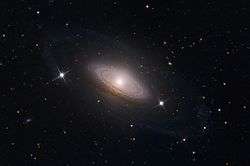NGC 4698
NGC 4698 is a barred spiral galaxy[5] located around 55[3] million light years away from Earth in the constellation of Virgo. It belongs to the Virgo Cluster of galaxies and is positioned near the northeastern edge of this assemblage.[4] The morphological classification of NGC 4698 in the De Vaucouleurs system is SA(s)ab,[3] which indicates a purely spiral structure with moderate to tightly wound arms.[7] It is inclined to the line of sight from the Earth by an angle of 53° along a position angle of 170°.[8]
| NGC 4698 | |
|---|---|
 NGC 4698 imaged with the 32-inch Schulman Telescope at Mount Lemmon Observatory | |
| Observation data (J2000 epoch) | |
| Constellation | Virgo |
| Right ascension | 12h 34m 20.310s[1] |
| Declination | +08° 11′ 51.94″[1] |
| Helio radial velocity | 1,002[2] km/s |
| Distance | 54.8 Mly (16.8 Mpc)[3] |
| Group or cluster | Virgo Cluster |
| Apparent magnitude (V) | 10.6[4] |
| Apparent magnitude (B) | 11.46[5] |
| Characteristics | |
| Type | SA(s)ab[3] |
| Apparent size (V) | 4′.0 × 2′.9[4] |
| Notable features | Seyfert-2 galaxy[6] |
| Other designations | |
| PGC 43254, UGC 7970, VCC 2070 | |
A unique feature of this galaxy is that the stars and dust of the nuclear disk are rotating in a direction that is aligned perpendicularly to the galactic disk. The bulge likewise appears elongated out of the galactic plane. This unusual alignment may have been the result of a past merger event.[5]
NGC 4698 is classified as a Seyfert-2 galaxy with an active galactic nucleus, which displays a prominent emission of radio and X-ray energy from the core while showing narrow emission lines in the optical spectrum.[6] The unified model of Seyfert galaxies proposes that the nucleus of a Seyfert 2 galaxy is obscured by a thick torus of gas and dust. However, the varying X-ray emission of the core of NGC 4698 shows little indication of being obstructed, suggesting instead that the source of the energy emission is generally unobscured but anemic in nature.[9]
References
- Skrutskie, M. F.; et al. (February 2006), "The Two Micron All Sky Survey (2MASS)", The Astronomical Journal, 131 (2): 1163–1183, Bibcode:2006AJ....131.1163S, doi:10.1086/498708.
- Crook, Aidan C.; et al. (February 2007), "Groups of Galaxies in the Two Micron All Sky Redshift Survey", The Astrophysical Journal, 655 (2): 790–813, arXiv:astro-ph/0610732, Bibcode:2007ApJ...655..790C, doi:10.1086/510201.
- de Looze, Ilse; et al. (October 2011), "The reliability of [C II] as an indicator of the star formation rate", Monthly Notices of the Royal Astronomical Society, 416 (4): 2712–2724, arXiv:1106.1643, Bibcode:2011MNRAS.416.2712D, doi:10.1111/j.1365-2966.2011.19223.x.
- Finlay, W. H. (2003), Concise Catalog of Deep-sky Objects: Astrophysical Information for 500 Galaxies, Clusters and Nebulae, Springer, p. 175, ISBN 978-1852336912.
- Corsini, E. M.; et al. (June 2012), "Polar bulges and polar nuclear discs: the case of NGC 4698", Monthly Notices of the Royal Astronomical Society: Letters, 423 (1): L79–L83, arXiv:1204.2265, Bibcode:2012MNRAS.423L..79C, doi:10.1111/j.1745-3933.2012.01261.x.
- Georgantopoulos, I.; et al. (September 2003), "Chandra Observations of NGC 4698: A Seyfert 2 Galaxy with No Absorption", The Astrophysical Journal, 594 (2): 704–708, arXiv:astro-ph/0305488, Bibcode:2003ApJ...594..704G, doi:10.1086/377120.
- Buta, Ronald J.; et al. (2007), Atlas of Galaxies, Cambridge University Press, pp. 13–17, ISBN 978-0521820486.
- Giovanardi, C.; et al. (March 1996), "Near-Infrared Low-Resolution Mapping of Early-Type Spirals", Astronomical Journal, 111 (2): 1086–1097, Bibcode:1996AJ....111.1086G, doi:10.1086/117854.
- Tran, Hien D.; et al. (January 2011), "Indecent Exposure in Seyfert 2 Galaxies: A Close Look", The Astrophysical Journal Letters, 726 (2): L21, arXiv:1012.1865, Bibcode:2011ApJ...726L..21T, doi:10.1088/2041-8205/726/2/L21.